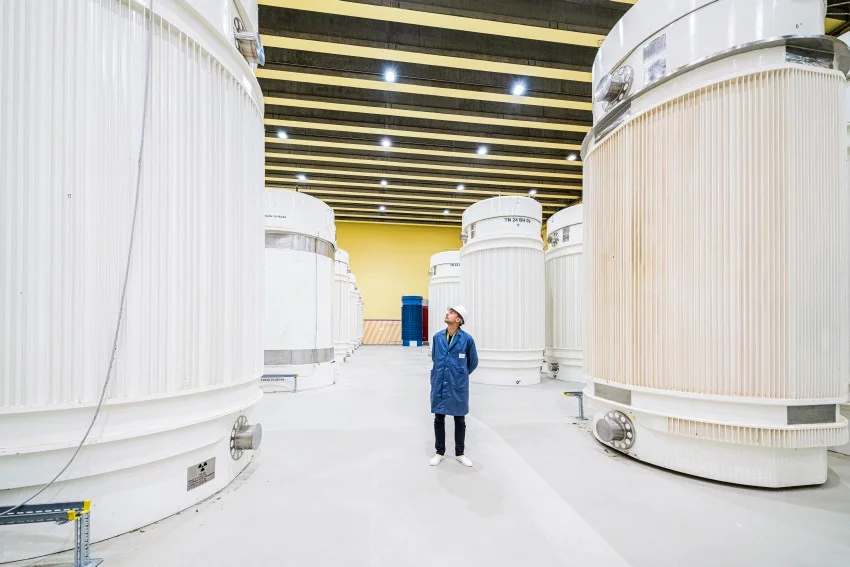In Switzerland, used nuclear fuel can look forward to a long and safe retirement deep underground. Until the geological repository is ready, fuel stays safely sealed and meticulously monitored in temporary dry storage. When the time comes, it will be transferred to specially designed canisters for the repository. By building simulations that predict how the fuel is evolving deep within the casks, PSI researchers are helping to optimise the transfer procedure from cask to canister and further enhance safety.
Within five metre high dry storage casks, beneath layers of steel and radiation absorbers and surrounded by an inert gas, used nuclear fuel rods wait patiently. They remain in dry storage, carefully monitored and safe even in the event of an earthquake or aeroplane crash, until the deep geological repository is ready.
Along the road from reactor to repository, the first stop for nuclear fuel following working life is wet storage. The used fuel is at first very hot, and spends several years cooling in huge water baths. Once cool enough to be handled, it is put into dry storage casks, which are stored in facilities such as ZWILAG in Würenlingen, Switzerland. Here, it is still hot: touch the outside of the casks - there is no risk of radiation due to the strong shielding - and they feel warm. Deep within these casks, the nuclear fuel continues to decay, for example, producing helium.
When the time comes for the used nuclear fuel to be transferred to the repository - likely to be many decades from now - the casks will be opened and the fuel transferred to a different container, known as canisters. As the fuel is still evolving whilst in dry storage, it will be important to predict its condition within the carefully sealed casks.
Hakim Ferroukhi head of the Laboratory for Reactor Physics and Thermal-Hydraulics at Paul Scherrer Institut PSI explains: “When the operation to put the fuel into canisters for the repository starts, it will be important to know precisely what to expect. This foresight will enable us to prepare for a safe transfer.”
To gain this foresight, researchers from PSI have teamed up with the Swiss Federal Nuclear Safety Inspectorate, ENSI. Together, they are developing computer models as part of a recently launched project, DRYstars, that simulate under various possible conditions the evolution of the fuel after it has been discharged from the reactor and placed into storage systems.
With the large research facilities giving insights into material behaviour on site, PSI is uniquely positioned to experimentally validate such models. Simulations become credible through testing against real data; yet for these long term questions, very little data is available. The DRYstars team are taking advantage of experiments conducted by the Laboratory of Nuclear Materials to perform preliminary validations of their models.
Scientific knowledge will enable optimised dry storage, canister designs and loadings
The transfer process, reassures Ferroukhi, will still be safe whatever the state of the fuel. Although the details are yet to be defined, the unloading of storage casks into disposal canisters will be undertaken in a dedicated encapsulation facility. This facility will be designed to ensure that fuel handling and transfer are performed under strictly controlled conditions and with all necessary shielding measures in place. More accurate foresight into the state of the fuel will nevertheless further enhance safety and enable the process to be carried out as efficiently as possible – for example, by knowing how gently to lift the fuel. It may also enable dry storage procedures to be adapted to optimise the condition of the fuel, as well as aiding future canister design. This may come hand in hand, explains Ferroukhi, with reducing the environmental footprint:
“Improved simulation capabilities to predict the evolution of a nuclear fuel rod from operation until placement in a canister will give us a strengthened scientific basis from which to further optimise canister design and associated loadings. And this could potentially allow the number of required canisters to be reduced, something that would in turn be beneficial for the environmental footprint. To put it simply, if we know more, we can improve efficiency and at the same time maintain the highest level of safety.”
Predicting phenomena that occur within the casks
To gain insight into the evolution of the fuel, the researchers considered several phenomena that may affect the thermomechanical properties of the fuel during an extended stay in dry storage. Based on the complex physical and chemical processes that govern them, their models predict the likelihood of these phenomena arising under various conditions. By imposing scenarios such as temperature and length of time during dry storage, they can then investigate the outcomes.
A dry storage cask typically contains several fuel assemblies, each made up of around hundred or more fuel rods. Each individual fuel rod is clad with zirconium alloy: a material optimised over decades of research to protect the fuel from corrosion and stop radioactive substances leaking out into the coolant water during operation in a reactor. Although any phenomena that affect the cladding during dry storage do so deep within the cask and do not present a risk of radiation leak, they are important to understand for the transfer procedure because of the influence they may have on the mechanical properties of the fuel.
One phenomenon that the researchers are investigating is the absorption of hydrogen into the cladding. During operation in a reactor, cladded fuel rods are submerged in water. With the high temperatures and pressures in the reactor, the zirconium alloy can react with water to produce hydrogen, which it then absorbs.
What happens to this hydrogen during dry storage depends on conditions within and around the fuel rods. At low temperatures and hydrogen concentrations, hydrogen absorbed in the cladding will remain dissolved. If the temperature rises, or a lot of hydrogen was absorbed, the hydrogen can instead react with metal atoms in the cladding and form compounds known as hydrides, which precipitate to form brittle, elongated structures. If these hydrides orientate themselves radially (that is, pointing across the wall of cladding), they can weaken the cladding and cause it to crack.
“In the case of hydrogen absorption,” explains Ferroukhi, “we need to first estimate how much hydrogen was absorbed during operation and how it has been distributed - this depends on exact details of its time in operation and the reactor it was used in. We can then investigate: How does it diffuse? Do hydrides form? How do they migrate? And in the end, the aim is to predict whether there could be radial reorientation or not.”
There are measures that can be taken to mitigate phenomena such as this. Phenomena that arise during dry storage are highly dependent on the conditions that the fuel was subjected to during reactor operation and wet storage. “We might find, for example, that a drying stage after wet storage makes a real difference to hydrogen behaviour,” says Ferroukhi. The simulations will thus enhance the scientific basis to make such informed decisions.
Text: Paul Scherrer Institute / Miriam Arrell
Contacts
Piotr Konarski
Principal Investigator
Paul Scherrer Institute
Forschungsstrasse 111, 5232 Villigen PSI, Switzerland
Email: Piotr.Konarski@psi.ch
Hakim Ferroukhi
Laboratory Head / Project Manager
Paul Scherrer Institute
Forschungsstrasse 111, 5232 Villigen PSI, Switzerland
Telephone: +41 56 310 40 62, email: Hakim.Ferroukhi@psi.ch
Selected Publications
P. Konarski, C. Cozzo, G. Khvostov, and H. Ferroukhi,
Spent nuclear fuel in dry storage conditions – current trends in fuel performance modeling,
J. Nucl. Mat., vol. 555, p. 153138, 2021
P. Konarski, C. Cozzo, G. Khvostov, and H. Ferroukhi,
Dry storage modeling activities at PSI: implementation and testing of a creep model for dry storage,
Kerntechnik, vol. 85, no. 6, pp. 419–425, 2020
P. Konarski, C. Cozzo, G. Khvostov, and H. Ferroukhi,
Extension of Falcon’s modelling capabilities to dry storage: development of a new model for hydrogen behavior in duplex claddings,
TopFuel 2021 Conference, Santander, Spain
Copyright
PSI provides image and/or video material free of charge for media coverage of the content of the above text. Use of this material for other purposes is not permitted. This also includes the transfer of the image and video material into databases as well as sale by third parties.

